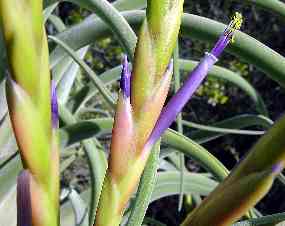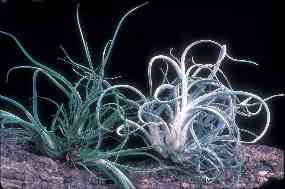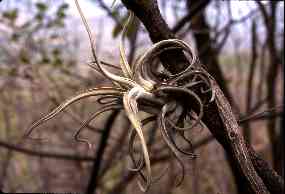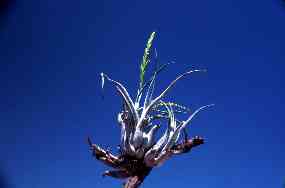Research and Conservation in Southern Sonora, Mexico
Tillandsia caput-medusae (mescal)
Rosettes of few, thick, stiff, twisted, white-lepidote leaves that are slightly inflated at the proximal end to form a bulbous base. Branched inflorescences have green or sometimes pinkish bracts and lavender flowers that are visited by hummingbirds. Flowering is in spring and summer. Widely-scattered small populations occur in tropical deciduous forest and oak woodland in Sonora, mostly on trees in humid canyons but occasionally in more exposed sites. The species ranges south to Central America.
Tillandsia caput-medusae, like most species in the genus, belongs to a specialized lifeform called an atmospheric epiphyte, colloquially called an air plant. The roots of atmospheric epiphytes are few and function mainly to anchor the plant to the substrate tree or rock. Water and nutrient absorption is performed mostly by the leaves. The leaf surfaces are covered with extremely hygroscopic peltate trichomes ("scales", shaped like tiny inverted umbrellas). When dry, the trichomes of many species are folded up, allowing maximum light to the leaf surface. They adsorb droplets of fog or rain almost instantly, unfold flat against the leaf, and hold the water between the underside of the scale and the leaf surface. The water is absorbed into the leaf over the next several hours. The leaves also absorb nutrients in the rainwater, dissolved from atmoshperic dust, bird droppings, and other debris that settles on the plants. Atmospheric epiphytes are common among mosses, ferns, and other nonflowering plants, but very rare among Angiosperms. This species is also clearly a succulent, the only such Tillandsia in Sonora although most epiphytic bromeliads are CAM.
 Bracts and flowers of Tillandsia caput-medusae. Photo: Mark Dimmitt |
Most Mexican Tillandsia species belong to the subgenus Tillandsia, characterized by long-tubular flowers which emerge from colored bracts that attract hummingbird pollinators. This subgenus usually sports brightly-colored bracts and lavender flowers. Sonoran Tillandsias typically have green or pale pink bracts; some also have green flowers. Apparently there is less competition for pollinators here and therefore less selection for bright colors. Tillandsia caput-medusae from Guatemala have bright red bracts.
The white color of Sonoran T. caput-medusae is due to a very dense cover of peltate scales. The more xerophytic species usually have the densest trichomes. This species ranges south into shadier, more humid habitats, where the leaves are green because there are fewer trichomes.
 Tillandsia caput-medusae in cultivation under the same conditions. Left: Guatemalan form; right: Sonoran form. Photo: Mark Dimmitt |
Rosettes live for a few years after flowering, producing offsets from the base. In the wild they usually fall off their substrates after a few generations because of increasing weight, but in cultivation they can grow into very large clusters.

